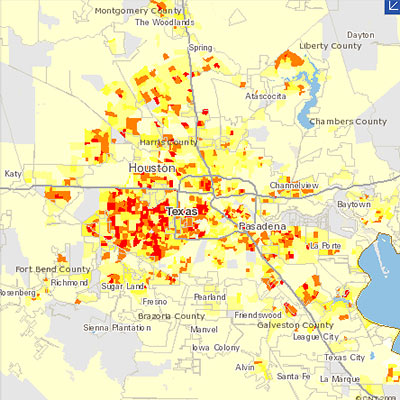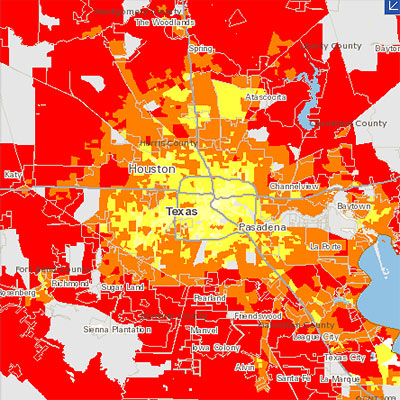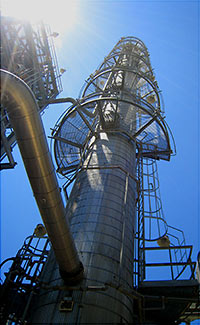COMMENT OF THE DAY: WE’RE FROM THE TEXAS MEDICAL CENTER AND WE’RE HERE TO HELP “Given all the refineries, industrial plants, chemical plants, railroads, stagnant swamps and cesspools, traffic pollution, and the like that plague this hellhole of a town, it is a freaking wonder that Houston doesn’t lead the nation in cancer cases.” [Random Poster, commenting on Today’s Odor in Baytown Is Brought to You by ExxonMobil]
Tag: Air Pollution
THE GIFT OF BENZENE What’s that faint, slightly sweet smell in the air? More from Chris Vogel’s report on Houston’s industrial emissions: “According to the City of Houston, a six-month survey in 2008 showed that six out of seven air monitors near the ship channel detected benzene levels above what the EPA says can cause cancer in ten out of every million people. That’s ten times higher than what is considered an acceptable risk. ‘Until recently I didn’t even know they were releasing any benzene into the atmosphere,’ says Dr. Charles Koller, a leukemia specialist at MD Anderson. ‘It’s shocking to me. It seems, frankly, criminal.’ It can take more than ten years for anemia to develop in someone who has been exposed to benzene, says Koller, and even longer for leukemia. A person also needs to be genetically susceptible. ‘We don’t know how susceptibility works,’ he says, ‘we just know that it works.’ . . . ‘Once benzene gets in the air,’ [Koller] says, ‘it’s everywhere. So even in Katy, there’s someone who, if they’re susceptible, will get [sick] from what’s going on in the Houston Ship Channel.’” [Houston Press]
FAILING THE PARTICLE BOARD REVIEW Levels of soot in Houston now exceed the EPA’s longstanding annual limit: “The area of concern is along the Ship Channel, the only place in Texas where levels of the tiny particles surpassed the EPA’s annual limit from 2006 to 2008, according to the most recent data available. The agency uses a three-year average to determine whether an area is in compliance. Monitoring shows air near the Ship Channel is getting cleaner, thanks in part to new rules for idling trucks and the paving of gravel parking lots. But EPA and local officials don’t know whether the improvements will be enough to drop the rolling average below the annual limit of 15 micrograms per cubic liter of air, since that average includes higher 2006 levels.” [Houston Chronicle; previously on Swamplot]
CEDAR BAYOU AIR UPSETS The Sierra Club and a Texas environmental group have filed suit against Chevron Phillips claiming a bonus supply of air pollutants and toxic chemicals has been escaping from the company’s Cedar Bayou chemical plant just north of I-10 in Baytown: “‘Like many companies in Texas, Chevron Phillips has repeatedly violated its own permit limits by emitting a wide range of harmful pollutants into the air from the Cedar Bayou plant,’ said Luke Metzger, Director of Environment Texas. ‘Because the state of Texas has failed to stop such violations at Cedar Bayou and elsewhere, citizen groups have had to step up and enforce the law themselves.’ The Clean Air Act contains a ‘citizen suit’ provision that allows private citizens affected by violations of the law to bring an enforcement suit in federal court if state and federal regulators do not. . . . Chevron Phillips’s permits contain both hourly and yearly limits on the amounts of pollutants it can emit into the atmosphere. The lawsuit alleges that equipment breakdowns, malfunctions, and other non-routine incidents at the Cedar Bayou complex have resulted in the release of more than a million pounds of pollutants into the surrounding air, frequently in violation of legal limits. A single such ‘upset’ or ’emission event’ can result in the release of tens of thousands of pounds of air pollutants in a matter of hours or even minutes.” [Environment Texas, via Houston Chronicle]
Katy residents living near a pool supply company got breathtaking views of the spectacular black plumes emanating from the RAM Chemical and Supply warehouse at 4949 Greenhouse Rd. during last weekend’s fire.
But the fun wasn’t entirely over: A separate episode yesterday resulted in a shelter-in-place order for a few hours last night — for downwind neighborhoods east of the Windstone Colony subdivision, stretching from Greenhouse Rd. to Barker Cypress. Fire officials warned of toxic clouds billowing out from a supply of hazardous chemicals still housed in the singed remains of the warehouse.
- Breaking News, Ram Chemical Warehouse Fire! [YouTube]
- RAM Chemical Fire, the Day After [iReport]
- Shelter In Place Order Lifted [Click2Houston]
- Warehouse fire prompts shelter-in-place [abc13]
- Cy-Fair warehouse fire prompts air-quality concerns [Houston Chronicle]
Video: Kevin Neugebauer


The Center for Neighborhood Technology has updated its interactive region-comparison website to show data comparing carbon dioxide emissions around the Houston region. The Housing + Transportation Affordability Index now allows you to compare CO2 emissions — from “household vehicle travel” only — on side-by-side zoomable maps.
The 2 new data sets available show CO2 emissions per acre (at the top above), and CO2 emissions per household (directly below that) from household auto use. The Houston-Galveston-Brazoria region is one of 55 U.S. metropolitan areas mapped on the website. The center’s point?
When measured on a per household basis, it found that the transportation-related emissions of people living in cities and compact neighborhoods can be nearly 70% less than those living in suburbs.
The center figures that transportation accounts for 28 percent of all greenhouse gas emissions in the U.S.
Other H+T map tools focus on how affordable different locations are to live in — when you take transportation costs into account:
SOOT’S US Some public-health and environmental groups are complaining that Houston isn’t getting enough respect for the particularly fine quality of the air here, and are asking the EPA to give this city the recognition it deserves: “Houston’s concentrations of soot — a piercing mix of airborne matter from diesel exhaust, industrial flares and road grit, among other sources — exceeded the EPA’s yearly standards from 2005 to 2007, according to the most recent federal data available. . . . ‘Residents of Houston are breathing unhealthy levels of soot pollution,’ [the NRDC’s John] Walke said in an interview this week. . . . Soot has been a special concern near the Houston Ship Channel, which is home to heavy industry and a busy port. It’s the only place in Texas where the particulate-matter levels exceed the annual standard.” [Houston Chronicle]
HOUSTON LOOKS GOOD IN SOOT Publicizing ozone problems is a smart strategy for Houston, because the city gets to be compared to L.A.! But that’ll get all mucked up if we have to start paying attention to particle pollution too. Fortunately, that isn’t happening quite yet: “In 2006, the EPA lowered the limit on how much soot Americans can be exposed to in 24 hours from 65 micrograms per cubic meter of air to 35. But the agency left unchanged the annual limit — an average of 15 micrograms per cubic meter per day over the course of a year. The agency’s science advisers recommended an annual standard as low as 13 micrograms to protect public health. Since then, Houston’s year-round levels of particles have worsened, averaging about 15 micrograms per day for each year. But the region remains in compliance because the EPA doesn’t plan to look at the cities violating the annual standard until it’s lowered again.” [Houston Chronicle]
 Finding it hard to stay healthy in Houston? Do you find yourself wheezing and coughing . . . maybe because you’re uh, so out of shape? Blogger and chemical-plant worker Baytown Bert has come up with a solution: Industrial Trekking.
Finding it hard to stay healthy in Houston? Do you find yourself wheezing and coughing . . . maybe because you’re uh, so out of shape? Blogger and chemical-plant worker Baytown Bert has come up with a solution: Industrial Trekking.
Industrial Trekking (IndyTrek) is a planned path consisting of climbing/walking obstacles or evolutions inside a refinery, chemical plant, factory, water treatment plant or even a large office building whereby a person can use stairs and ladders to promote fitness. An IndyTrek typically consists of 8-10 evolutions, usually requiring an hour to complete.
What a great way to get out, lose some weight, and get some fresh air, too! But how can anyone find the time?
I do it on the clock, as I can do it while strolling through the Chemical Plant I work in, but it can be done anywhere stairs are and in time-frame sections, throughout the day until all the evolutions are completed. It can be incorporated into your daily schedule (while on the clock or on break).
After the jump: A Baytown Bert photo shows an IndyTrekker in action!

